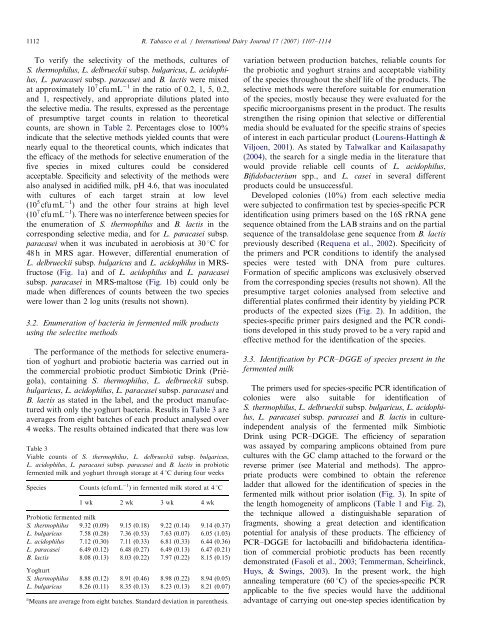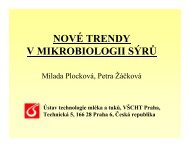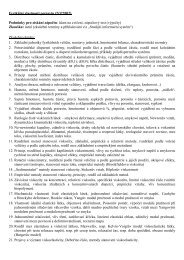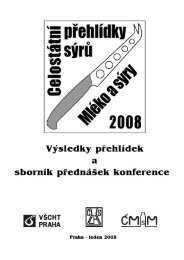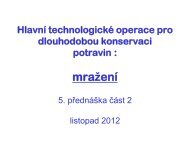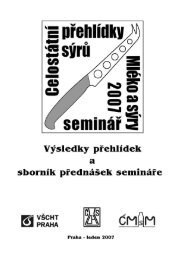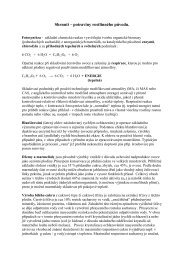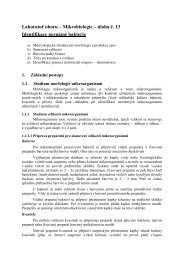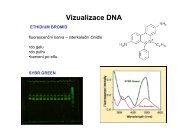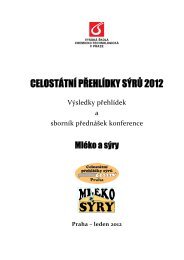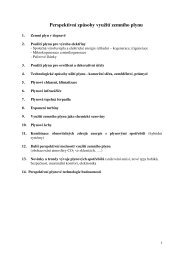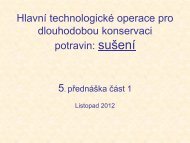Selective enumeration and identification of mixed cultures of ...
Selective enumeration and identification of mixed cultures of ...
Selective enumeration and identification of mixed cultures of ...
Create successful ePaper yourself
Turn your PDF publications into a flip-book with our unique Google optimized e-Paper software.
1112<br />
To verify the selectivity <strong>of</strong> the methods, <strong>cultures</strong> <strong>of</strong><br />
S. thermophilus, L. delbrueckii subsp. bulgaricus, L. acidophilus,<br />
L. paracasei subsp. paracasei <strong>and</strong> B. lactis were <strong>mixed</strong><br />
at approximately 10 7 cfu mL 1 in the ratio <strong>of</strong> 0.2, 1, 5, 0.2,<br />
<strong>and</strong> 1, respectively, <strong>and</strong> appropriate dilutions plated into<br />
the selective media. The results, expressed as the percentage<br />
<strong>of</strong> presumptive target counts in relation to theoretical<br />
counts, are shown in Table 2. Percentages close to 100%<br />
indicate that the selective methods yielded counts that were<br />
nearly equal to the theoretical counts, which indicates that<br />
the efficacy <strong>of</strong> the methods for selective <strong>enumeration</strong> <strong>of</strong> the<br />
five species in <strong>mixed</strong> <strong>cultures</strong> could be considered<br />
acceptable. Specificity <strong>and</strong> selectivity <strong>of</strong> the methods were<br />
also analysed in acidified milk, pH 4.6, that was inoculated<br />
with <strong>cultures</strong> <strong>of</strong> each target strain at low level<br />
(10 5 cfu mL 1 ) <strong>and</strong> the other four strains at high level<br />
(10 7 cfu mL 1 ). There was no interference between species for<br />
the <strong>enumeration</strong> <strong>of</strong> S. thermophilus <strong>and</strong> B. lactis in the<br />
corresponding selective media, <strong>and</strong> for L. paracasei subsp.<br />
paracasei when it was incubated in aerobiosis at 30 1C for<br />
48 h in MRS agar. However, differential <strong>enumeration</strong> <strong>of</strong><br />
L. delbrueckii subsp. bulgaricus <strong>and</strong> L. acidophilus in MRSfructose<br />
(Fig. 1a) <strong>and</strong><strong>of</strong>L. acidophilus <strong>and</strong> L. paracasei<br />
subsp. paracasei in MRS-maltose (Fig. 1b) could only be<br />
made when differences <strong>of</strong> counts between the two species<br />
were lower than 2 log units (results not shown).<br />
3.2. Enumeration <strong>of</strong> bacteria in fermented milk products<br />
using the selective methods<br />
The performance <strong>of</strong> the methods for selective <strong>enumeration</strong><br />
<strong>of</strong> yoghurt <strong>and</strong> probiotic bacteria was carried out in<br />
the commercial probiotic product Simbiotic Drink (Prie´gola),<br />
containing S. thermophilus, L. delbrueckii subsp.<br />
bulgaricus, L. acidophilus, L. paracasei subsp. paracasei <strong>and</strong><br />
B. lactis as stated in the label, <strong>and</strong> the product manufactured<br />
with only the yoghurt bacteria. Results in Table 3 are<br />
averages from eight batches <strong>of</strong> each product analysed over<br />
4 weeks. The results obtained indicated that there was low<br />
Table 3<br />
Viable counts <strong>of</strong> S. thermophilus, L. delbrueckii subsp. bulgaricus,<br />
L. acidophilus, L. paracasei subsp. paracasei <strong>and</strong> B. lactis in probiotic<br />
fermented milk <strong>and</strong> yoghurt through storage at 4 1C during four weeks<br />
Species Counts (cfu mL 1 ) in fermented milk stored at 4 1C<br />
1wk 2wk 3wk 4wk<br />
Probiotic fermented milk<br />
S. thermophilus 9.32 (0.09) 9.15 (0.18) 9.22 (0.14) 9.14 (0.37)<br />
L. bulgaricus 7.58 (0.28) 7.36 (0.53) 7.63 (0.07) 6.05 (1.03)<br />
L. acidophilus 7.12 (0.30) 7.11 (0.33) 6.81 (0.33) 6.44 (0.36)<br />
L. paracasei 6.49 (0.12) 6.48 (0.27) 6.49 (0.13) 6.47 (0.21)<br />
B. lactis 8.08 (0.13) 8.03 (0.22) 7.97 (0.22) 8.15 (0.15)<br />
Yoghurt<br />
S. thermophilus 8.88 (0.12) 8.91 (0.46) 8.98 (0.22) 8.94 (0.05)<br />
L. bulgaricus 8.26 (0.11) 8.35 (0.13) 8.23 (0.13) 8.21 (0.07)<br />
a Means are average from eight batches. St<strong>and</strong>ard deviation in parenthesis.<br />
ARTICLE IN PRESS<br />
R. Tabasco et al. / International Dairy Journal 17 (2007) 1107–1114<br />
variation between production batches, reliable counts for<br />
the probiotic <strong>and</strong> yoghurt strains <strong>and</strong> acceptable viability<br />
<strong>of</strong> the species throughout the shelf life <strong>of</strong> the products. The<br />
selective methods were therefore suitable for <strong>enumeration</strong><br />
<strong>of</strong> the species, mostly because they were evaluated for the<br />
specific microorganisms present in the product. The results<br />
strengthen the rising opinion that selective or differential<br />
media should be evaluated for the specific strains <strong>of</strong> species<br />
<strong>of</strong> interest in each particular product (Lourens-Hattingh &<br />
Viljoen, 2001). As stated by Talwalkar <strong>and</strong> Kailasapathy<br />
(2004), the search for a single media in the literature that<br />
would provide reliable cell counts <strong>of</strong> L. acidophilus,<br />
Bifidobacterium spp., <strong>and</strong> L. casei in several different<br />
products could be unsuccessful.<br />
Developed colonies (10%) from each selective media<br />
were subjected to confirmation test by species-specific PCR<br />
<strong>identification</strong> using primers based on the 16S rRNA gene<br />
sequence obtained from the LAB strains <strong>and</strong> on the partial<br />
sequence <strong>of</strong> the transaldolase gene sequence from B. lactis<br />
previously described (Requena et al., 2002). Specificity <strong>of</strong><br />
the primers <strong>and</strong> PCR conditions to identify the analysed<br />
species were tested with DNA from pure <strong>cultures</strong>.<br />
Formation <strong>of</strong> specific amplicons was exclusively observed<br />
from the corresponding species (results not shown). All the<br />
presumptive target colonies analysed from selective <strong>and</strong><br />
differential plates confirmed their identity by yielding PCR<br />
products <strong>of</strong> the expected sizes (Fig. 2). In addition, the<br />
species-specific primer pairs designed <strong>and</strong> the PCR conditions<br />
developed in this study proved to be a very rapid <strong>and</strong><br />
effective method for the <strong>identification</strong> <strong>of</strong> the species.<br />
3.3. Identification by PCR–DGGE <strong>of</strong> species present in the<br />
fermented milk<br />
The primers used for species-specific PCR <strong>identification</strong> <strong>of</strong><br />
colonies were also suitable for <strong>identification</strong> <strong>of</strong><br />
S. thermophilus, L. delbrueckii subsp. bulgaricus, L. acidophilus,<br />
L. paracasei subsp. paracasei <strong>and</strong> B. lactis in cultureindependent<br />
analysis <strong>of</strong> the fermented milk Simbiotic<br />
Drink using PCR–DGGE. The efficiency <strong>of</strong> separation<br />
was assayed by comparing amplicons obtained from pure<br />
<strong>cultures</strong> with the GC clamp attached to the forward or the<br />
reverse primer (see Material <strong>and</strong> methods). The appropriate<br />
products were combined to obtain the reference<br />
ladder that allowed for the <strong>identification</strong> <strong>of</strong> species in the<br />
fermented milk without prior isolation (Fig. 3). In spite <strong>of</strong><br />
the length homogeneity <strong>of</strong> amplicons (Table 1 <strong>and</strong> Fig. 2),<br />
the technique allowed a distinguishable separation <strong>of</strong><br />
fragments, showing a great detection <strong>and</strong> <strong>identification</strong><br />
potential for analysis <strong>of</strong> these products. The efficiency <strong>of</strong><br />
PCR–DGGE for lactobacilli <strong>and</strong> bifidobacteria <strong>identification</strong><br />
<strong>of</strong> commercial probiotic products has been recently<br />
demonstrated (Fasoli et al., 2003; Temmerman, Scheirlinck,<br />
Huys, & Swings, 2003). In the present work, the high<br />
annealing temperature (60 1C) <strong>of</strong> the species-specific PCR<br />
applicable to the five species would have the additional<br />
advantage <strong>of</strong> carrying out one-step species <strong>identification</strong> by


